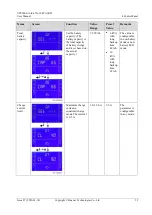
UPS2000-A-(6 kVA-10 kVA)-RTL
User Manual
5 Operations
Issue 07 (2020-01-10)
Copyright © Huawei Technologies Co., Ltd.
60
The number of batteries set on the LCD for the UPS with long backup time should be
consistent with the actual number. If batteries are added or removed, change the related
parameters on the LCD accordingly. The battery lifespan will be shortened if the value on the
LCD is less than the actual number, or a battery leakage or even a fire disaster may occur if
the value is greater.
The parameter values in the screenshots are for reference only. Set the parameters as
required.
Set the voltage level and frequency based on the rated voltage and frequency. In the case
of single-phase output, set the voltage level to 220 V (default), 230 V, or 240 V.
Battery parameters are configurable for the UPS with long backup time in non-battery
mode or non-battery ECO mode.
Set the number of batteries based on the actual battery capacity. The default value is 16
and the value range is 16 to 20.
Set the battery capacity to the total capacity of all battery strings. The default values for
the 6 kVA UPS with long backup time and 10 kVA UPS with long backup time is 40 Ah
and 65 Ah respectively. The value range is 7 Ah to 999 Ah.
To set a parameter, on the parameter setting screen, press
and then ▲ or ▼, and press
to
confirm.
Starting the UPS in Normal Mode
Step 1
If the battery circuit has a circuit breaker, switch on the external battery circuit breaker. If the
battery circuit does not have a circuit breaker, connect battery cables.
Step 2
Close the UPS upstream AC input circuit breaker and the AC input circuit breaker on the rear
panel of the UPS.
Step 3
After the LCD screen lights up for 1s, the initialization screen is displayed. After the progress
bar is complete, the default screen is displayed, as shown in
Figure 5-1
Power-on and default screen
Step 4
Set the voltage level based on the actual output voltage. The voltage level can be set to 220 V
(default), 230 V, or 240 V.
















































